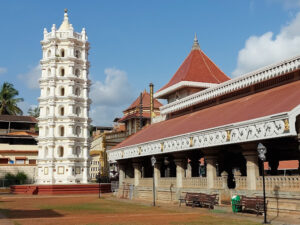Not merely a religious center, but also an esteemed repository of Goan cultural heritage: the Shri Mahalasa Temple. Its rituals–festivals and architectural nuances–provide an intricate insight into the opulent traditions that define this region at its core.
Architectural Elegance:
The simple yet elegant design of the temple’s architecture attests to the Goan style. Intricate carvings adorn the sanctum sanctorum, showcasing this region’s artistic brilliance.
Within the Mardol temple complex, one may also encounter smaller shrines dedicated to the goddesses Shantadurga (Santeri), Lakshmi Narayan (Vishnu with his consort Lakshmi), and Mahalasa. The grounds of this temple house five principal ganas or attendants of Mahalasa: Grampurush, Bhagwati, Dadh – Simha Purush; furthermore – there is an established practice where daily adoration begins not directly with the primary goddess but precedes her by showing reverence towards all these deities.
The temple’s employees actively manage the canteen, where they offer Prasad – a sacred meal – following both morning and evening aartis.
The enormous brass bell of the temple in Goa boasts a well-known reputation; however, it remains unrung–its ringer unattached. Only when a witness expressed their desire to testify did they connect the clapper: an event that rarely occurred. It was thought the goddess would


 Source- Wikipedia
Source- Wikipedia 